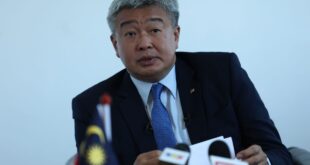KUALA LUMPUR: Japan began discharging treated water from the Fukushima Daaiichi nuclear power plant into the sea at noon Malaysian time on Thursday (Aug 24), and will monitor radioactivity levels in the sea and surroundings with the International Atomic Energy Agency (IAEA).
First Secretary of the Japanese Embassy in Malaysia Yosuke Kurotani said with continued IAEA involvement from an independent standpoint, Japan and the Tokyo Electric Power Company (Tepco) remain committed to ensure a safe discharge.
ALSO READ: Public urged to remain calm over Fukushima treated water release
“Japan will… conduct three types of monitoring, namely monitoring of treated water in tanks, real-time monitoring, and sea area monitoring.
“If some event occurs, such as radioactivity levels exceeding standards, appropriate measures including stopping the discharge or suspending the discharge will be taken.
“Furthermore, the results of monitoring by the Japanese government and Tepco will be made public both domestically and internationally.
ALSO READ: More nuclear challenges await Japan after Fukushima water release
“We will continue to make every effort to ensure a safe discharge, with the continued involvement of the IAEA, including its reviews,” he said.
Kurotani had been asked on about preparations at the Fukushima power plant for the release of over 1.33 million cubic metres of treated water that had accumulated at the site since the 2011 nuclear disaster following the Tohoku earthquake and tsunami.
He pointed out the decision to release the treated water was made based on a technical validation process, along with weather and sea conditions during the discharge.
“Specifically, when releasing advanced liquid processing system (ALPS) treated water into the ocean, it has already been confirmed that radioactive substances other than tritium are below the regulatory standards before release, and only tritium that meets the regulatory standards will be released into the ocean.
“However, it will take about two days to confirm the final safety,” he said.
Global communities may check and follow the latest updates on the event through Tepco’s official website.
ALSO READ: Hong Kong to curb some Japan food imports over Fukushima water release
International media reported that the Japanese government said releasing the water was a necessary step in the lengthy and costly process of decommissioning the plant, which sits on the country’s east coast about 220km north-east of the capital Tokyo.
Japan has been collecting and storing the contaminated water in tanks for more than a decade, but space is running out, added the reports.
However, neighbours South Korea and China have voiced their opposition to Japan’s move, fearing it could have negative long-term consequences. – BK
 BeritaKini.biz Berita Viral Terkini di Malaysia
BeritaKini.biz Berita Viral Terkini di Malaysia





